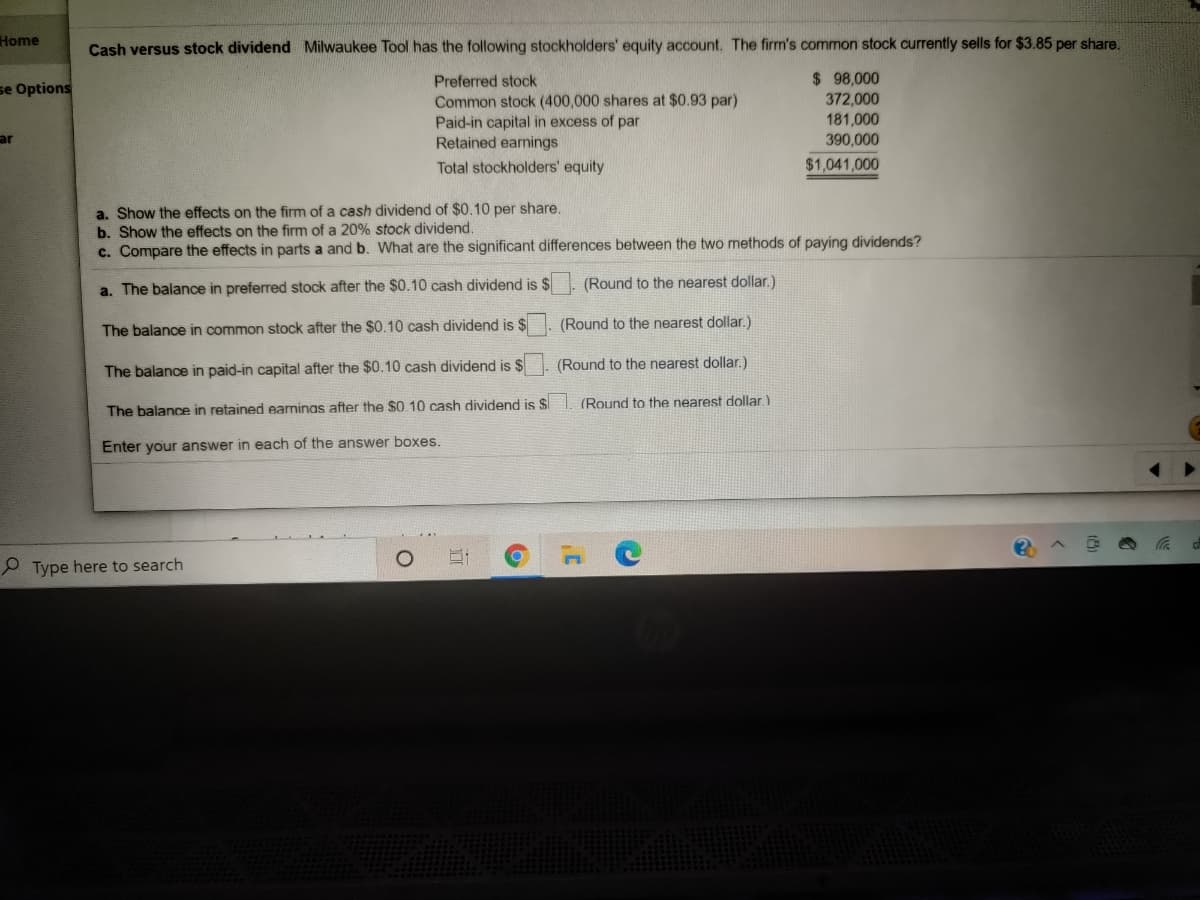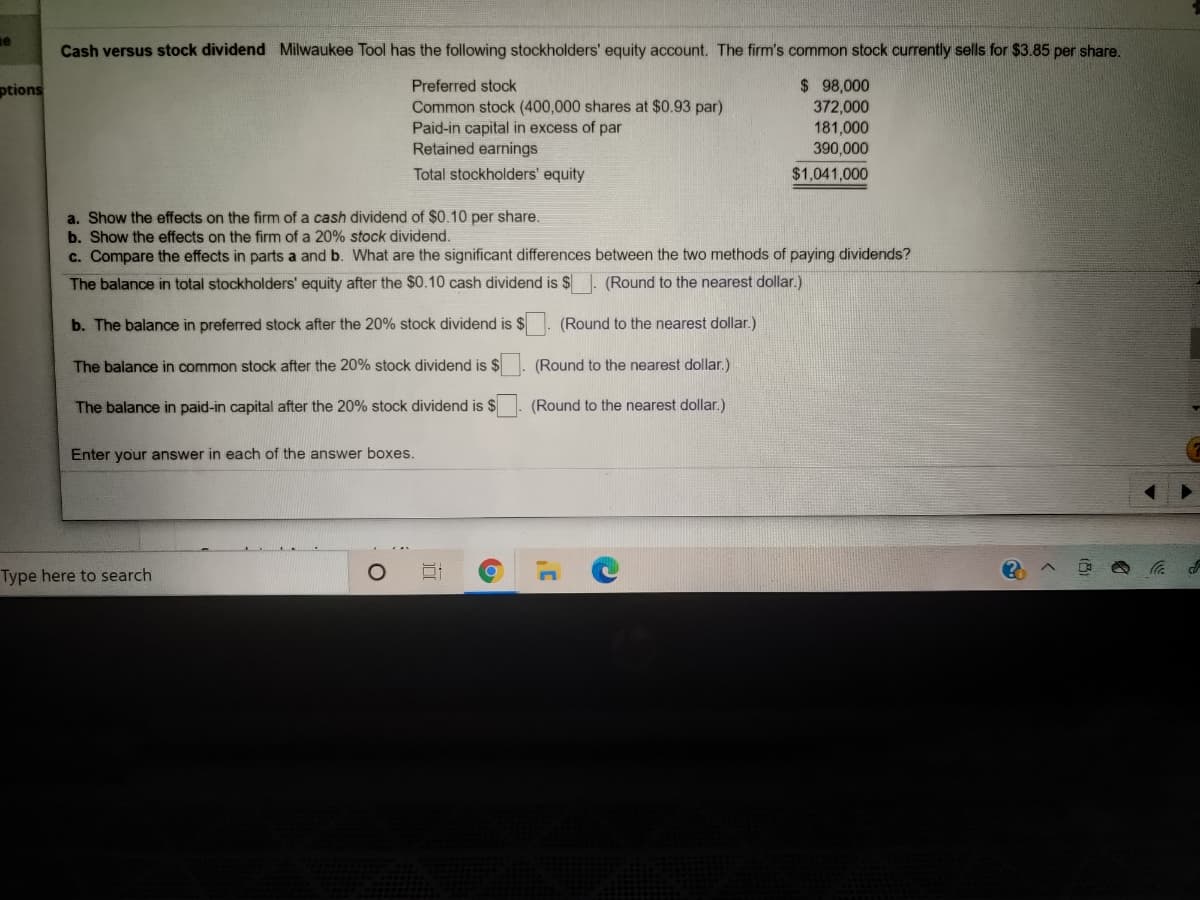a. The balance in preferred stock after the $0.10 cash dividend is $. (Round to the nearest dollar.) The balance in common stock after the $0.10 cash dividend is $. (Round to the nearest dollar.) The balance in paid-in capital after the $0.10 cash dividend is $ (Round to the nearest dollar.)
a. The balance in preferred stock after the $0.10 cash dividend is $. (Round to the nearest dollar.) The balance in common stock after the $0.10 cash dividend is $. (Round to the nearest dollar.) The balance in paid-in capital after the $0.10 cash dividend is $ (Round to the nearest dollar.)
Cornerstones of Financial Accounting
4th Edition
ISBN:9781337690881
Author:Jay Rich, Jeff Jones
Publisher:Jay Rich, Jeff Jones
Chapter10: Stockholder's Equity
Section: Chapter Questions
Problem 67E: Cash Dividends on Common and Preferred Stock Lemon Inc. has the following information regarding its...
Related questions
Question

Transcribed Image Text:Home
Cash versus stock dividend Milwaukee Tool has the following stockholders' equity account. The firm's common stock currently sells for $3.85 per share.
$ 98,000
372,000
181,000
390,000
Preferred stock
se Options
Common stock (400,000 shares at $0.93 par)
Paid-in capital in excess of par
Retained earnings
ar
Total stockholders' equity
$1,041,000
a. Show the effects on the firm of a cash dividend of $0.10 per share.
b. Show the effects on the firm of a 20% stock dividend.
c. Compare the effects in parts a and b. What are the significant differences between the two methods of paying dividends?
a. The balance in preferred stock after the $0.10 cash dividend is $
(Round to the nearest dollar.)
(Round to the nearest dollar.)
The balance in common stock after the $0.10 cash dividend is $
(Round to the nearest dollar.)
The balance in paid-in capital after the $0.10 cash dividend is $
The balance in retained earnings after the $0.10 cash dividend is $1. (Round to the nearest dollar.)
Enter your answer in each of the answer boxes.
O Type here to search

Transcribed Image Text:e
Cash versus stock dividend Milwaukee Tool has the following stockholders' equity account. The firm's common stock currently sells for $3.85 per share.
$ 98,000
372,000
ptions
Preferred stock
Common stock (400,000 shares at $0.93 par)
Paid-in capital in excess of par
Retained earnings
181,000
390,000
Total stockholders' equity
$1,041,000
a. Show the effects on the firm of a cash dividend of $0.10 per share.
b. Show the effects on the firm of a 20% stock dividend.
c. Compare the effects in parts a and b. What are the significant differences between the two methods of paying dividends?
The balance in total stockholders' equity after the $0.10 cash dividend is $ . (Round to the nearest dollar.)
b. The balance in preferred stock after the 20% stock dividend is $
(Round to the nearest dollar.)
The balance in common stock after the 20% stock dividend is $
(Round to the nearest dollar.)
The balance in paid-in capital after the 20% stock dividend is $
(Round to the nearest dollar.)
Enter your answer in each of the answer boxes.
Type here to search
Expert Solution
This question has been solved!
Explore an expertly crafted, step-by-step solution for a thorough understanding of key concepts.
This is a popular solution!
Trending now
This is a popular solution!
Step by step
Solved in 4 steps with 2 images

Knowledge Booster
Learn more about
Need a deep-dive on the concept behind this application? Look no further. Learn more about this topic, finance and related others by exploring similar questions and additional content below.Recommended textbooks for you

Cornerstones of Financial Accounting
Accounting
ISBN:
9781337690881
Author:
Jay Rich, Jeff Jones
Publisher:
Cengage Learning

College Accounting, Chapters 1-27
Accounting
ISBN:
9781337794756
Author:
HEINTZ, James A.
Publisher:
Cengage Learning,

Financial Accounting: The Impact on Decision Make…
Accounting
ISBN:
9781305654174
Author:
Gary A. Porter, Curtis L. Norton
Publisher:
Cengage Learning

Cornerstones of Financial Accounting
Accounting
ISBN:
9781337690881
Author:
Jay Rich, Jeff Jones
Publisher:
Cengage Learning

College Accounting, Chapters 1-27
Accounting
ISBN:
9781337794756
Author:
HEINTZ, James A.
Publisher:
Cengage Learning,

Financial Accounting: The Impact on Decision Make…
Accounting
ISBN:
9781305654174
Author:
Gary A. Porter, Curtis L. Norton
Publisher:
Cengage Learning

Intermediate Accounting: Reporting And Analysis
Accounting
ISBN:
9781337788281
Author:
James M. Wahlen, Jefferson P. Jones, Donald Pagach
Publisher:
Cengage Learning

Pfin (with Mindtap, 1 Term Printed Access Card) (…
Finance
ISBN:
9780357033609
Author:
Randall Billingsley, Lawrence J. Gitman, Michael D. Joehnk
Publisher:
Cengage Learning
